Back in 2017, one of the best preserved fossils discovered was making the rounds. It was named Borealopelta markmitchelli, “Mark Mitchell’s northern shield”, honoring the man who spent more than 7,000 hours carefully preparing the fossil material, and slowly carving it out from the rock it rested in. It was first discovered in March of 2011 in the oil sands near Fort McMurray, Alberta, when Shawn Funk, a miner, working for the Suncor Energy company, struck it while excavating. From there the Royal Ontario Museum was contacted, setting in motion the extraction of the fossil. Unfortunately, during the process of lifting it out, the fossil shattered. Thankfully most of the material was salvaged, and thanks to Mark Mitchell’s countless hard work and patience preparing and unearthing the specimen, one of the world’s best preserved nodosaurids, if not dinosaurs altogether, is now able to be viewed in public at the ROM. Now in 2023, it is great to see Mattel has finally gotten around to making a figure (and a corresponding mini figure) of this well preserved dinosaur, which has been one of the most important paleontological discoveries in the last decade, if not this century. So, how did they do?

I suppose it is worth noting that Mattel’s figures are not advertised or marketed as being paleo-accurate or educational in any sense, and many of them have typical problems with their anatomy. This figure is no exception to that, perhaps sadly, as this would have been one of the best to get it right due to how readily available the material is to reference from, either from the countless images online, or the scientific description by Brown et al. 2017. Though in the meantime, I appreciate the attempt, since until Creative Beast Studio can possibly put one out that’s a bit more rigorous in the anatomy, this one does get some aspects right at least. There are also surprisingly very few Borealopelta figures on the market as it is, despite the recognition it had and its well preserved remains. In fact, after the 2018 Kaiyodo, 2019 CollectA, and 2020 PNSO iterations, this is only the fourth figure of it (and fifth counting the mini) that I’m aware of. Before addressing the anatomy it’s worth briefly mentioning this figure has a little bit of articulation at the neck, which can be rotated, and positioned up and down. The limbs and tail also can be rotated, and that’s the extent of articulation on the figure. Now to delve into those aspects that they got both right and wrong.
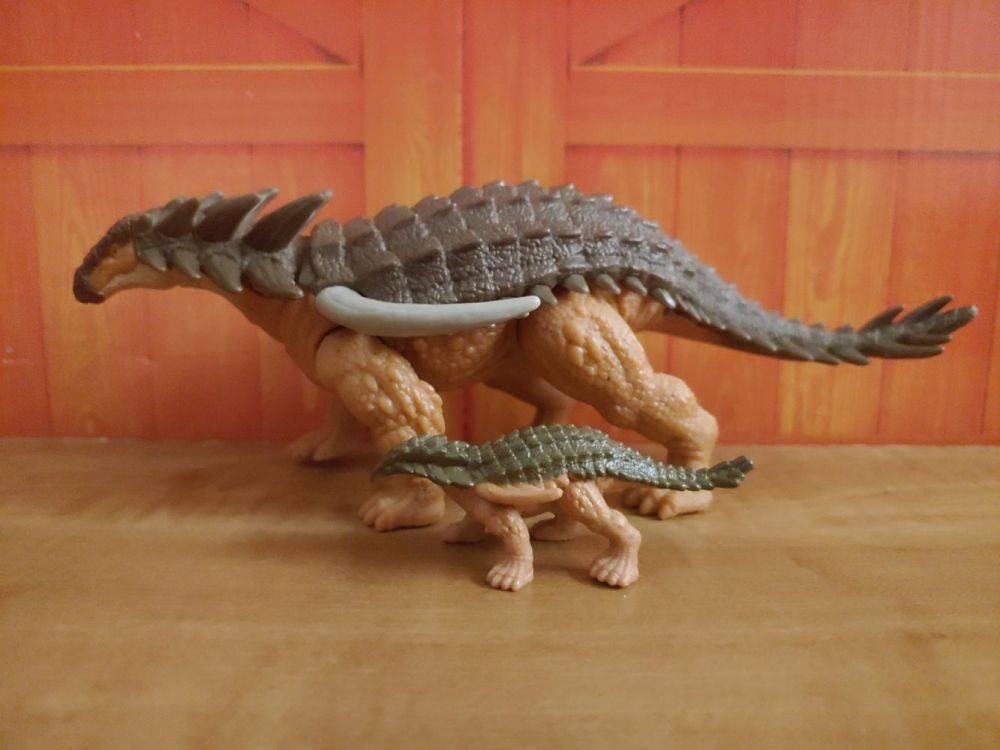
The skull is sculpted with numerous smaller plates, but they don’t resemble the fossil material, at least not entirely. Of note is the lack of the frontoparietal dermal plate, which was large and round, on the posterior part of the skull, above the orbits or the eye sockets. The overall shape of the skull is consistent with the fossil material, at least from a side view, but not quite from a top view. The shape on the figure is more triangular, but on the fossil material it is wider at the back portion, and narrows at the snout, concave-like. It is overall proportioned correctly with the skull being rather small and a neck that increases in width the closer it is to the body. There are tiny horizontal slits sculpted on the sides, above the beak, likely intended to represent the nostrils. They seem to be placed more or less correctly, but appear to be more round in shape on the fossil.
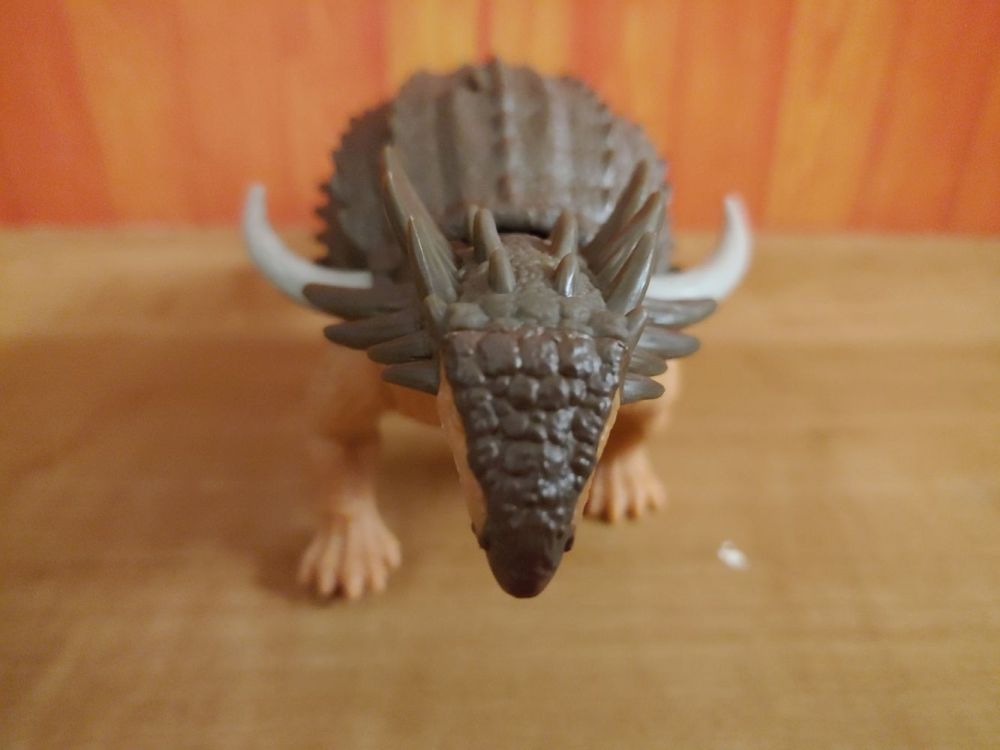
The neck on the figure was given three rows of six spike-like osteoderms, covered in scaly skin, with an extra pair of four horns or spikes at the base of the head. The inner pair is smaller, while the outer pairs are larger. The fossil on the other hand sports three rows of six keeled osteoderms on the neck, covered in layers of keratin and skin, similar to the skin covering of a crocodilian’s osteoderms. In between the rows of osteoderms were small (basement epidermal) scales. Missing from the figure are the transitional osteoderms and a pair of spines before the large shoulder spines, which have been overlooked or omitted for one reason or another.
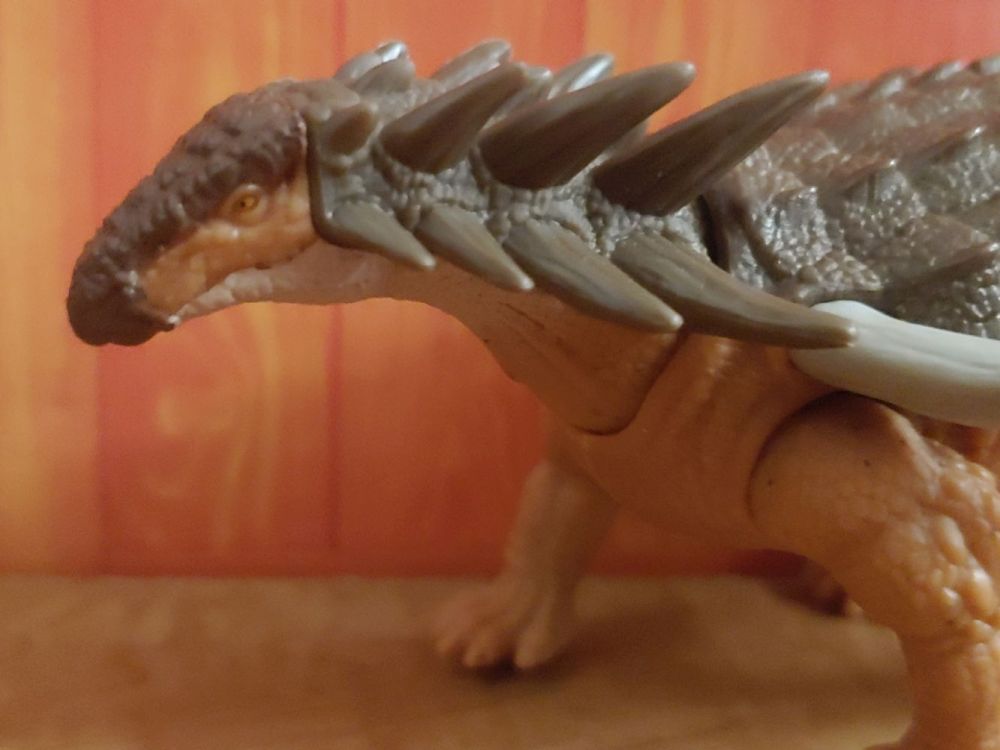
The top of the head on the figure is painted brown, the eyes are painted yellow with tiny black specks for the pupils, and the neck is painted a cream color. This is about the extent of paint on the figure, with the exception of the shoulder spines which were either painted white, or cast in white plastic. The body of the figure predominantly continues the brown of the head, and the underside is a reddish orange color. The fossil material preserved pigments showing the animal would have had a reddish-brown coloration, and was countershaded. While the top of the body could perhaps be more red in color, at least the figure is countershaded, dark on top, lighter on the bottom. That said, one of the simple reconstructions from the 2017 paper by Brown et al., shows the animal with a brown-like colored back, red-orange legs, and a white underside from the bottom of the head/neck to the belly and undersides of the legs. It was also depicted with tan colored shoulder spikes. Perhaps what Mattel did is entirely within reason. It’s also worth noting the shoulder spines consisted of bony cores covered in thick keratinized horny sheaths, different from the surrounding osteoderms on the fossil. It might have resembled the horns of mammals, or may have been colored similarly to the skin of the animal.
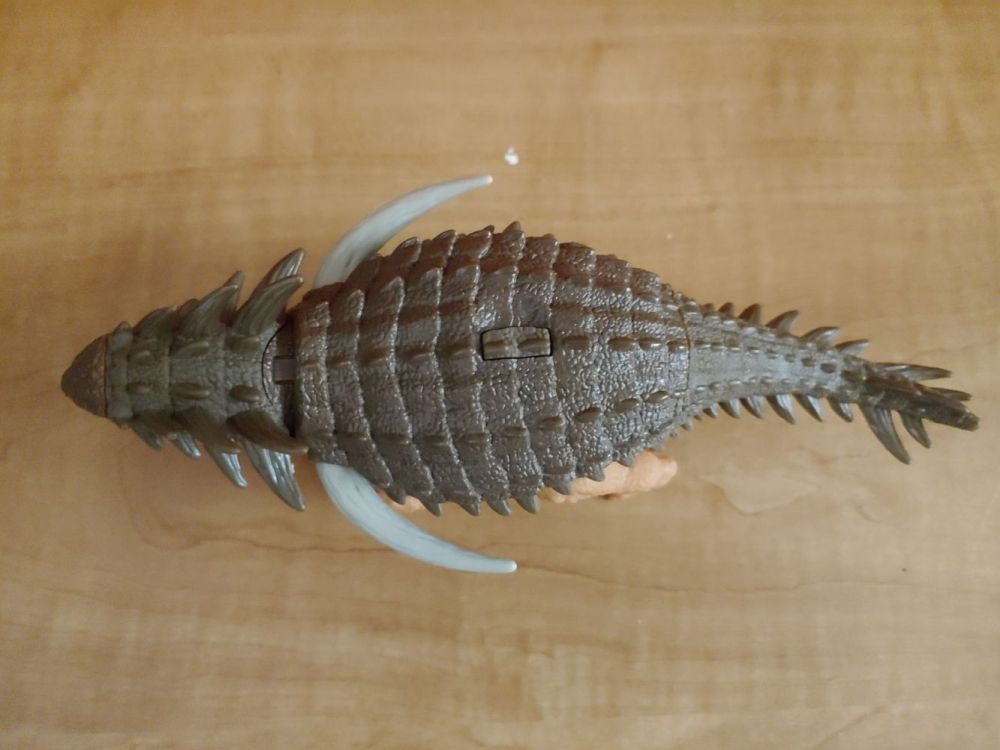
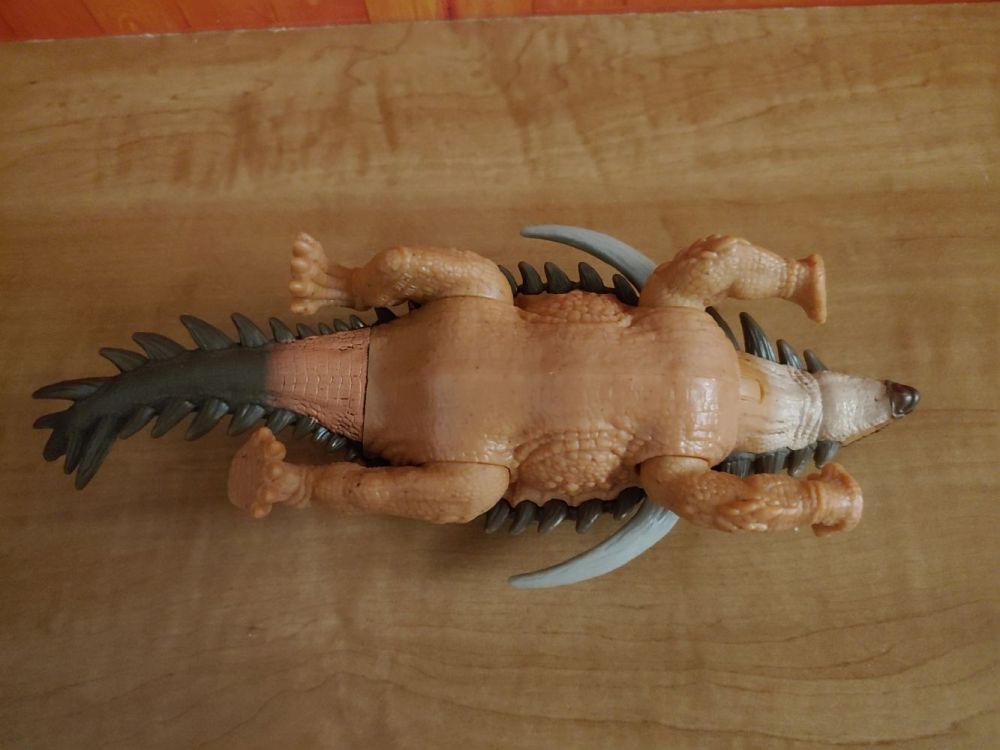
Moving onto the body’s armor arrangement, it has many rows of osteoderms with scaly skin in between the smooth keeled tips. As mentioned before the scales should be between the rows of osteoderms, not particularly on top of them, as the sculptor has done on the figure. Starting from the row with the shoulder spines, post neck articulation, the figure has eleven rows of osteoderms before the tail articulation. The first row has three (or five including the shoulder spines), seven from the second to the 11th row, the last of which is where the tail articulation starts, which cuts through some of the rows. The rows on the tail go from seven to five, before the tip with the very large spikes. The actual animal had a less even distribution of osteoderms. Rather, this is individual variation or unique morphology for this species, it might be hard to say until another specimen is found.
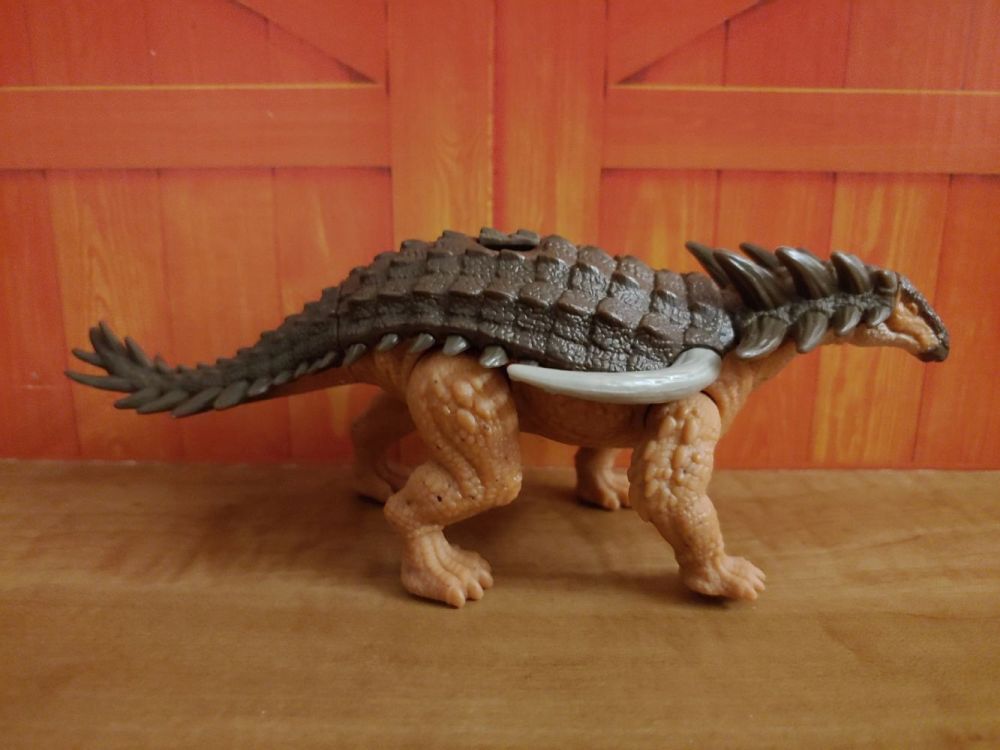
The row with the shoulder spines has ten osteoderms, the second row with about 12-14 osteoderms, the third has six, the fourth with about 16, the fifth with about 14-16, the sixth with 11, the seventh with 12-14, the eighth with 14-16, the ninth with 12. Due to the incomplete material there may be more in each row not preserved. From the 10th row (remaining late thoracic and sacral portions) and onwards the fossil is much more incomplete. That said there are at least ten partial osteoderms in the 10th row, nine partial osteoderms in row 11, with ten partial osteoderms in row 12. It is also worth noting that there are osteoderms on both the forelimbs and hindlimbs on the figure, and at least the former is consistent with the fossil material.
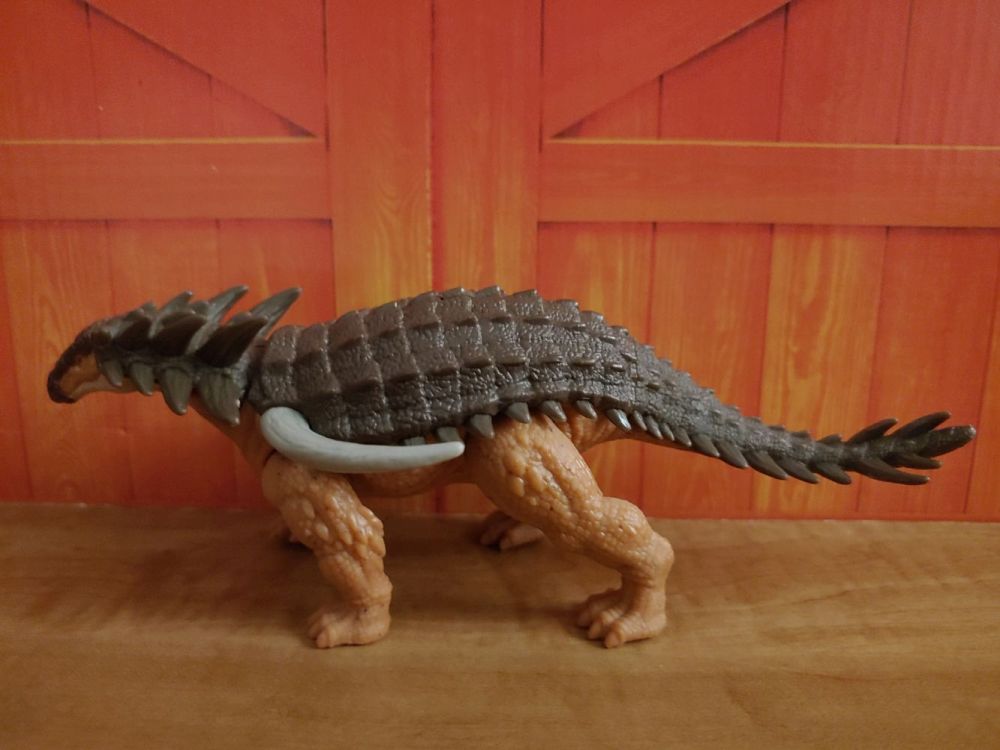
The latter half of Borealopelta is unknown, as the one and only holotype specimen had its back half destroyed unintentionally when it was struck at the oil sands near Fort McMurray when it was initially discovered. An unfortunate price for what led to the amazing discovery of the remaining front portion. Th Mattel figure’s tail is reasonable if not exaggerated, based on relatives such as Sauropelta, if not other nodosaurids. It correctly lacks a tail club. Like Borealopelta, a specimen of Sauropelta (AMNH 3036) has also been preserved in situ, which allows a better look at the armor arrangement and other key aspects it would have while the animal was still alive. This specimen also preserved a large portion of the tail, giving an idea of its proportions. It was rather long, and it is possible Borealopelta may have had a similar tail. The exaggerated spines at the tip of the tail are purely speculative, and almost resemble the spikes on the tails of stegosaurs, a related group of thyreophorans that nodosaurids also belong to.

The figure sports five digits on the manus/hands, and five digits on the pes/feet, with claws or unguals on each digit. Five digits on the manus/hands would be correct, though they should only have three claws at most, like its relatives and many other dinosaurs and archosaurs. Five digits on the pes/feet seems to be incorrect as many other nodosaurids and some basal thyreophorans show this characteristic. Most nodosaurs lack reasonably good remains in this particular area (including Borealopelta itself, although the paper did mention it has material from the manus and pes, but did not go into detail about them). However, a few have been preserved with enough material to get an idea. Some examples include the thyreophoran Scelidosaurus, ankylosaur Stegouros, and nodosaurids Peloroplites and Sauropelta, which have enough material from the hands to show they had five digits there. Scelidosaurus, Peloroplites, and Sauropelta also have unguals/claws on the first three digits, while the fourth and fifth lacked them.
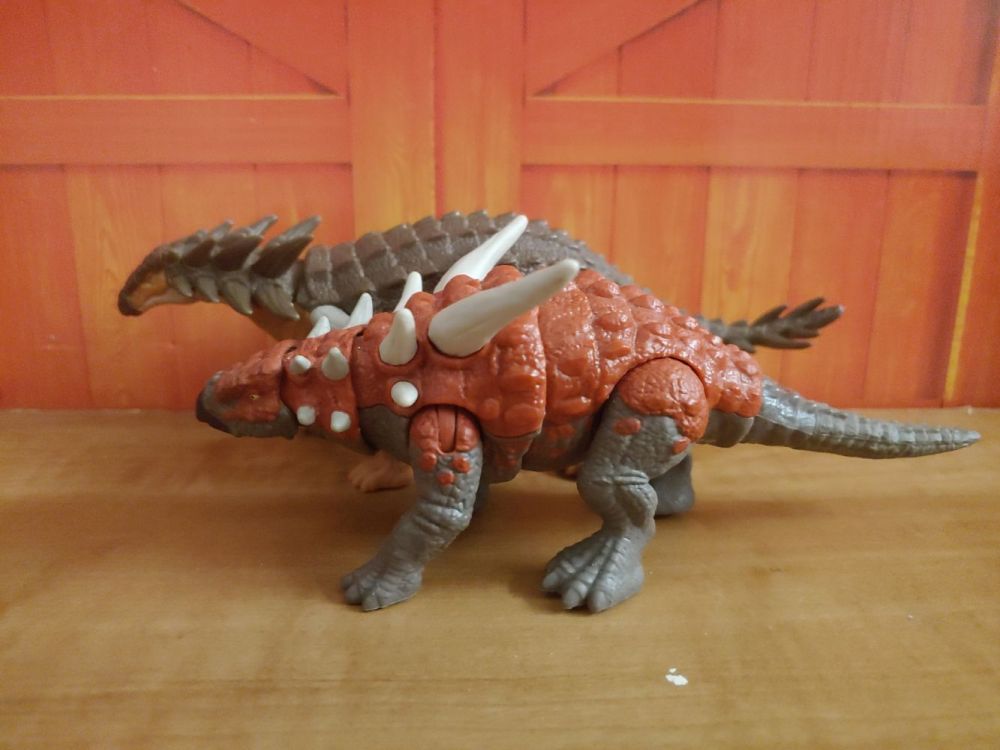
Regarding the pes/feet, Scelidosaurus, Stegouros, and the nodosaurids Europelta, Mymoorapelta, Niobrarasaurus, and Sauropelta all have been preserved with four toes, and with unguals on each of these toes. Many of these specimens’ unguals have additionally been described as being hoof-like in shape. Additionally a trackway designated as Tetrapodosaurus (which may have been left behind by Sauropelta or close relative) also shows five digits on the manus/hands, and four on the pes/feet. The trackway also shows the hands had a half moon shape similar to the likes of sauropods, with the feet more full and round. With the exception of having an extra fifth digit on the feet, the toes otherwise seem to be oriented correctly, with the first being the shortest. The first digits on the hands should probably be oriented differently, as it gives it the appearance of a thumb, and the bottoms are flat and full like on the feet, in contrast to the half moon shape from the trackways if not the skeletal material for the above.
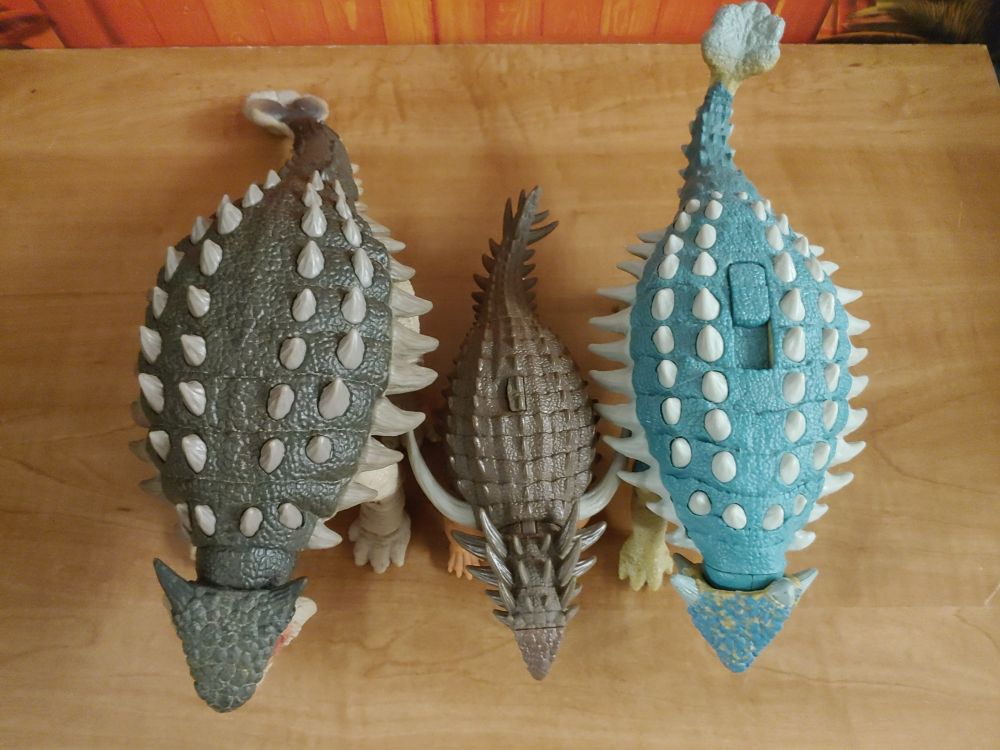
Despite the large amount of artistic liberties taken, and therefore inaccuracy, I still think this is a fun, stylized tribute to one of the most remarkable fossil discoveries within the past decade, if not all time. I also think it is one of Mattel’s better releases this year. Unless you can track this figure down for retail price at a local retailer, you might need to be ready to shell out for more to get your hands on this one as I did (from Amazon for under $18, a bit overpriced, but cheaper then Ebay). It is worth mentioning that Mattel also has a figure of the earlier mentioned Stegouros releasing, which is another recently described, well preserved ankylosaur, much like Borelopelta. They also formerly made a figure of Sauropelta as well (in red or green colors).
Disclaimer: links to Ebay and Amazon on the DinoToyBlog are affiliate links, so we make a small commission if you use them. Thanks for supporting us!



It’s a shame Mattel didn’t take the opportunity to be more diligent with this one, but I also like it regardless. Aesthetically it’s still one of the nicer dinosaur figures they’ve put out recently.
Inaccuracies aside, I really like this one too. I was able to find mine at Walmart but it wasn’t around for long. I guess they need to keep those pegs full of Quilmesaurus and Velociraptor.